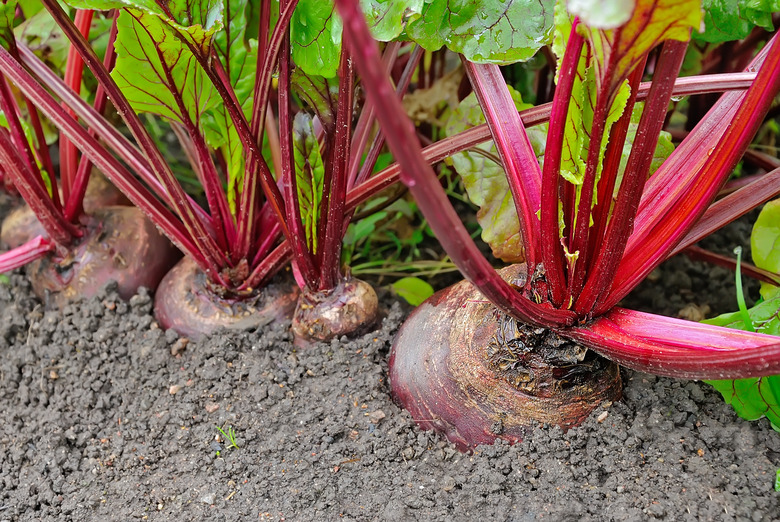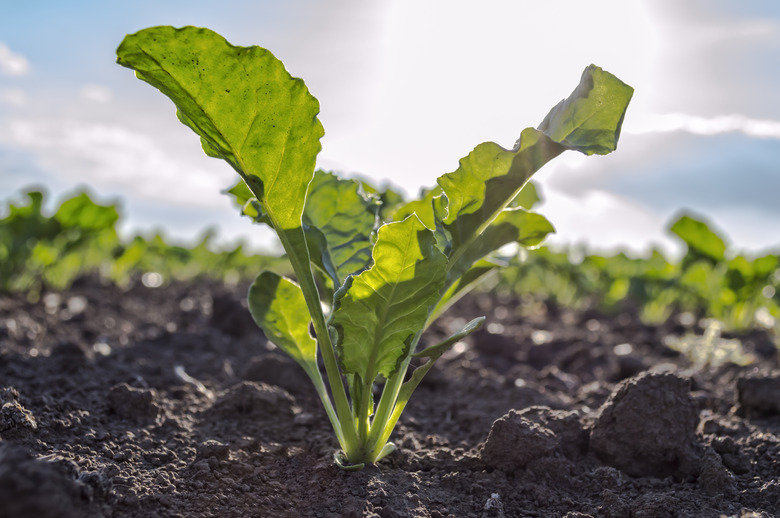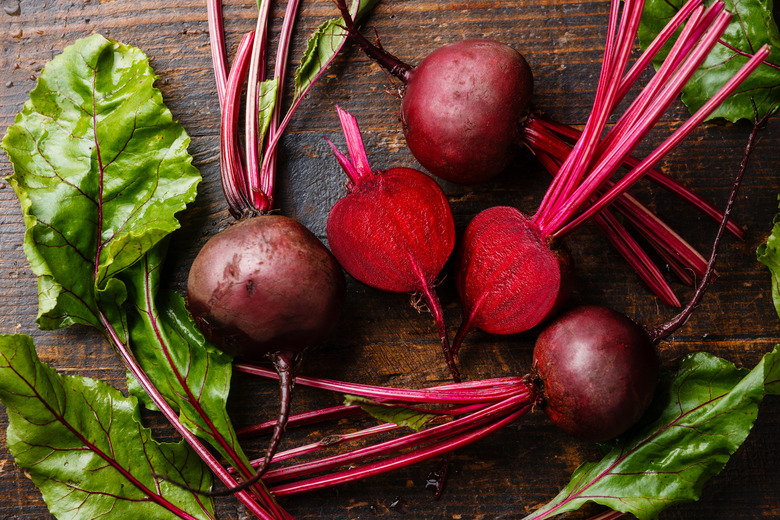How To Grow Beets
We may receive a commission on purchases made from links.
If you grow beets (Beta vulgaris) in your vegetable garden, you'll be cultivating a versatile and nutritious plant. Depending on the type of beet plant you grow, you can eat the shoots (leaves), the roots, or both. Beets are grouped into four categories that comprise two primary groups: those that are grown as root vegetables and those that are grown as leafy vegetables.
As a root crop, the familiar red beetroot, which has also been bred to produce different colors, has edible leaves that are called beet greens or beet tops. Sugar beets are white, and although all parts are edible, they're grown as a source of sugar because of the high concentration of sucrose in their roots.
Some beets grow without developing a swollen tuberous root; these are cultivated solely for the leaves they bear. Swiss chard is one example of a beet that doesn't produce a swollen root. It's cultivated exclusively for its leaves.
Although the beet plant is botanically classified as an herbaceous biennial, it's grown as an annual crop with harvestable leaves and/or roots that mature during one growing season. Regardless of the type of beet you choose for your garden, you'll follow the same basic growing guidelines.
Best Uses for Beets
Best Uses for Beets
With the myriad uses for beetroots and beet greens, you can choose to enjoy them fresh, steamed, sautéed, baked, broiled, microwaved, and even pickled. Whether you're a longtime beet fan or you're ready to expand your palate to include this healthy vegetable in your diet, you can also mix beets into your favorite smoothie – roots and/or shoots – for a nutritional boost. The high level of nitrates in beets may even lower your blood pressure.
How to Grow Beet Plants From Seed
How to Grow Beet Plants From Seed
- Sow beetroot seeds 1 to 2 inches
apart in a raised furrow (a long, narrow trench) that's 1/2 inch deep, lightly cover the seeds with
sand or loose soil. - Gently sprinkle with water.
- Thin seedlings 2 to 3 inches
apart after they sprout, which typically occurs in 7 to 14 days, by snipping them with scissors instead of pulling them.
Leafy beet plants can be started from seed indoors about four to six weeks before you transplant them in the garden. Here's how:
- Fill a container with soilless seed-starting mix. You can use round flower pots or seed-starting trays but make sure the container has a drainage hole.
- Wet the mix until water drains from the bottom
of the container. - Sow seeds 1/2 inch deep and thin seedlings 2 to
3 inches apart. You can loosely cover the container with a plastic bag to
increase the humidity and boost germination, or you can simply place an
uncovered container in a warm, brightly lit spot out of direct sun. - Keep the
mix damp but not soggy and remove the plastic bag after sprouting.
Starting Beet Plants From Seedlings
Starting Beet Plants From Seedlings
Transplant beet seedlings by planting them at the same depth in the garden as they were growing in the seed-starting mix. When transplanting young plants, be careful not to damage the roots so that future root growth is not compromised, particularly if you're growing beetroot plants instead of beet greens. If you transplant beets in early spring during cold weather, you may want to cover the tender seedlings with a floating row cover to help protect them from frost damage. You can also mulch around the beet seedlings to help insulate them and to conserve water. They'll put on faster growth when the weather is cool in spring and fall, although plants will continue to grow from early to late summer.
In What Zone Do Beet Plants Grow Best?
In What Zone Do Beet Plants Grow Best?
Although beet grows as an annual plant in USDA zones 2 through 11, it's a cool-weather crop that prospers when the air is chilly. When chilly air gives way to a late-spring frost, young transplants may suffer.
When Should You Plant Beets?
When Should You Plant Beets?
If you're starting from seedlings, transplant beets in early spring as soon as the soil can be worked. If you're direct-sowing beet seeds, the soil temperature must be at least 40 degrees Fahrenheit for the seeds to germinate, and their best germination rates occur when the soil temperature is between 75 and 85 degrees. The actual date is different for different climate zones; for example, this is around April 15 in Maryland. Because soil temperature differs from ambient air temperature, you can use a soil thermometer for accuracy.
Soil, Sunlight and Water Recommendations for Beet Plants
Soil, Sunlight and Water Recommendations for Beet Plants
Like other root crops, beetroot grows best in loose, crumbly, well-draining soil with a soil pH of 6.0 to 8.0 that's rich in organic matter. In heavy soil such as clay, the roots cannot properly develop. To break up heavy clay, spread several inches of compost on top of the soil and spade it in to a depth of at least 6 inches. Perhaps the easiest way to grow beets where the native soil is heavy or otherwise compacted is to grow these plants in raised beds that contain lots of organic matter. Raised beds also provide good drainage, which is another must have for growing beets.
Growing beets in full sun — at least six hours each day — is optimal. Although they'll also grow in partial shade, it will take a little longer for the plants to mature to a harvestable size.
Beets prefer moist soil, which means that you'll have to water plants more often in hot weather if rainfall doesn't keep the soil hydrated. During dry weather, water the plants deeply instead of lightly sprinkling the soil. A 2- to 3-inch layer of mulch around plants helps keep the soil cool and moist.
Avoid a heavy hand with fertilizer around beets. This is a crop that doesn't need or want much fertilizer. Specifically, steer clear of high-nitrogen fertilizers. Beets respond better to organic fertilizers, which release nutrients slowly. Your local cooperative extension service will perform a soil test based on a sample you take and can give specific fertilizer recommendations for the soil in your garden.
How to Harvest Beetroot and Beet Leaves
How to Harvest Beetroot and Beet Leaves
Gardening tips for harvesting beets depend on whether you're growing them for their roots or leaves.
You can harvest baby beets when the roots are just over an inch in diameter, or you can wait until the roots are 3 inches or larger to get more bang for your buck. The harvesting window is typically between 50 and 80 days after the seeds have germinated. If you continue planting more beets every few weeks, you'll have a longer harvesting season.
If you're growing beets for leafy greens, you'll be able to harvest baby greens as soon as 30 days after germination. Pick mature leaves approximately 60 days after germination. Beet plants continue to produce leaves throughout the season. You can even harvest all the leaves at once by cutting them 2 inches above the crown, and plants will regenerate new leaves.
If you harvest a fall crop of beets, you'll be able to keep them in outside storage for up to three months by keeping them cool. You can store beets in a root cellar or an unheated garage. If you store them in the refrigerator, they'll stay fresh for several weeks.
Common Pests and Other Problems for Beet Plants
Common Pests and Other Problems for Beet Plants
Beets are relatively free of pest problems. Occasional insect damage may result from leaf miners, leafhoppers, aphids, caterpillars and flea beetles. Use synthetic insecticides sparingly since this is an edible crop. A few holes chewed in the leaves may be within an acceptable damage threshold.
If the pest problem exceeds your damage threshold, however, you can use some organic control methods. For example, Bt controls caterpillars, and sulfur controls other insect pests. For aphids, you can simply send a spray of water to dislodge these pests. Even if you're using an organic control, be sure to follow all label recommendations.
Boron is a plant micronutrient, which means that plants need this element in very small quantities, but beets are sensitive to a boron deficiency when there are insufficient quantities in soil. Early symptoms include new leaves that emerge malformed before turning yellow and then brown and beet roots that are stained with black spots. This is a plant that's worth the nominal price for a soil test to identify whether there's a need for supplemental boron.
Common Diseases of Beet Plants
Common Diseases of Beet Plants
A few diseases may affect beets, including leaf spots, powdery mildew, downy mildew and root rot. With these fungal diseases, by the time you notice symptoms, it's hard to cure the disease, and fungicides are most effective when applied as a preventive measure before symptoms ever appear. Other than spotted leaves, you may see other symptoms such as wilting; white, cottony growth on upper leaves; and yellowish-green growth on the undersides of leaves. Providing optimal growing conditions yields stronger plants that can better withstand diseases.
Often, when gardeners see plants wilt, they think the plant needs more water, but sometimes, the wilting is caused by root rots because of too much water or soil that doesn't drain well. Choosing disease-tolerant beets goes a long way toward fending off pathogens. Two beet cultivars with high disease resistance are 'Red Ace' and 'Moneta.'


